
Maulbronn Monastery is a former Cistercian abbey and ecclesiastical state in the Holy Roman Empire located at Maulbronn, Baden-Württemberg. The monastery complex, one of the best-preserved in Europe, was named a UNESCO World Heritage Site in 1993.
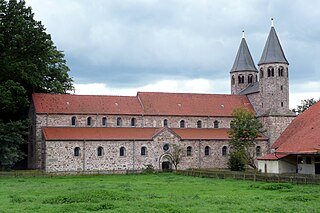
Bursfelde Abbey is a former Benedictine monastery located in Bursfelde, a hamlet which for administrative purposes is included in the municipality of nearby Hannoversch Münden in Lower Saxony, Germany. Today the abbey church and its estate cover a site of approximately 300 hectares which is administered by the Klosterkammer Hannover, a body that operates under the auspices of the Lower Saxony Ministry for Arts and the Sciences to look after reassigned or disused ecclesiastical buildings and other heritage properties in the region. The legal owner of the Bursfelde Monastery Complex is the Evangelical-Lutheran Church of Hanover.

Neuburg Abbey near Heidelberg in Baden-Württemberg is a Benedictine monastery dedicated to Saint Bartholomew, and part of the Beuronese Congregation.
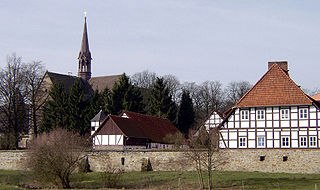
Loccum Abbey is a Lutheran monastery in the town of Rehburg-Loccum, Lower Saxony, near Steinhude Lake.

Himmerod Abbey was a Cistercian monastery in the community of Großlittgen in the Verbandsgemeinde of Manderscheid in the district of Bernkastel-Wittlich, Rhineland-Palatinate, Germany, located in the Eifel, in the valley of the Salm.

Walkenried Abbey was a Cistercian abbey located in the village of Walkenried in Lower Saxony, Germany. Founded in 1127 on the southern rim of the Harz mountain range, the remnants of the monastic complex since 2010 are part of the Upper Harz Water Regale World Heritage Site.

The Imperial Abbey of Kaisersheim, was a Cistercian monastery in Kaisersheim, Bavaria, Germany.

Langheim Abbey was a well-known Cistercian monastery in Klosterlangheim, part of the town of Lichtenfels in Upper Franconia, Bavaria, Germany, in the Bishopric of Bamberg.

Kamp Abbey, also known as Altenkamp Abbey or Alt(en)feld Abbey was the first Cistercian monastery founded in German territory, in the present town of Kamp-Lintfort in North Rhine-Westphalia.
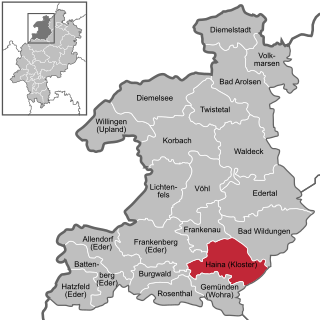
Haina (Kloster) is a municipality in Waldeck-Frankenberg in northwest Hesse, Germany.
Berno, Bishop of Schwerin, also known as the Apostle of the Obotrites or Berno of Amelungsborn was a pre-eminent missionary to the Obotrites in the territory of Mecklenburg, Germany, and the first Bishop of Schwerin.

Herrenalb Abbey is a former Cistercian monastery in the present Bad Herrenalb in Baden-Württemberg, Germany.

Riddagshausen Abbey was a Cistercian monastery just outside the city of Brunswick in Germany.

Esrum Abbey, also Esrom Abbey, was the second Cistercian monastery founded in Denmark, located near Hillerød in Region Hovedstaden, on the island of Zealand (Sjælland), on the north side of the Esrum Sø near Esbønderup and Græsted.
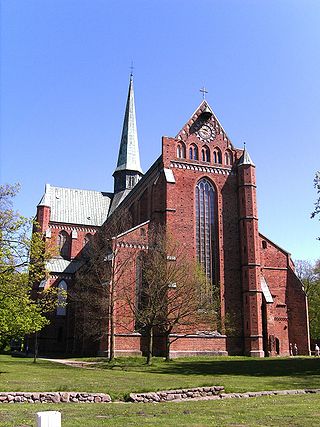
Doberan Abbey is a former Cistercian monastery in Bad Doberan, Mecklenburg-Vorpommern, Germany. The Brick Gothic church continues in use as Doberan Minster.
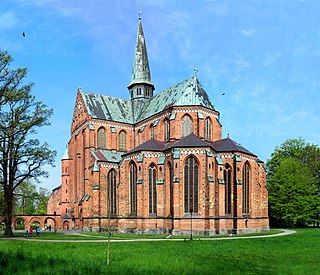
The Doberan Minster is the main Lutheran Church of Bad Doberan in Mecklenburg, Germany. Close to the Baltic Sea and the Hanseatic city of Rostock, it is the most important religious heritage of the European Route of Brick Gothic. It is the remaining part of the Ex-Cistercian Doberan Abbey, dedicated in 1368. The first abbey in Mecklenburg, founded in 1171, which was also used as the burial site for the regional rulers, became important both politically and historically.
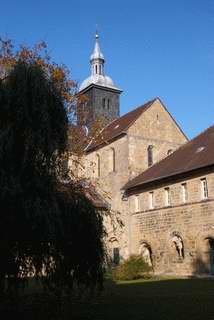
Mariental Abbey, in the present-day municipality of Mariental in Lower Saxony, Germany, is a former Cistercian monastery founded in 1138, now used and owned by a Lutheran congregation of the Evangelical Lutheran Church in Brunswick.
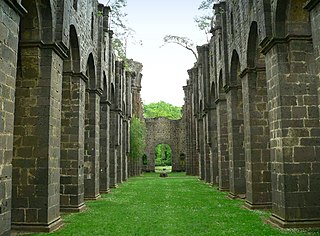
Arnsburg Abbey is a former Cistercian monastery near Lich in the Wetterau, Hesse, Germany. It was founded by monks from Eberbach Abbey in 1174. Although heavily damaged in the Thirty Years' War it was rebuilt later in the 17th century and prospered in the 18th century, when much of the abbey was rebuilt in Baroque style.
Siegfried IV was the last Count of Northeim-Boyneburg and Homburg. He gave the land at Amelungsborn for the foundation of the future Amelungsborn Abbey, a Cistercian monastery, which was officially settled by a community of monks from Altenkamp Abbey.

Buch Abbey, in German Kloster Buch, is a former Cistercian monastery near Leisnig in Saxony.




















